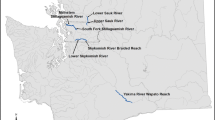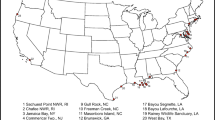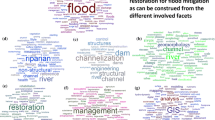Abstract
Wetland conservation is a critical environmental management issue. An emerging approach to this issue involves the construction of wetland environments. Because our understanding of wetlands function is incomplete and such projects must be monitored closely because they may have unanticipated impacts on ecological, hydrological, and geomorphological systems. Assessment of project-related impacts on stream channel stability is an important component of riverine wetlands construction and operation because enhanced erosion or deposition associated with unstable rivers can lead to loss of property, reductions in channel capacity, and degradation of water quality, aquatic habitat, and riparian aesthetics.
The water/sediment budget concept provides a scientific framework for evaluating the impact of riverine wetlands construction and operation on stream channel stability. This concept is based on the principle of conservation of mass, i.e., the total amount of water and sediment moving through a specific reach of river must be conserved. Long-term measurements of channel sediment storage and other water/sediment budget components provide the basis for distinguishing between project-related impacts and those resulting from other causes. Changes in channel sediment storage that occur as a result of changes in internal inputs of water or sediment signal a project-related impact, whereas those associated with changes in upstream or tributary inputs denote a change in environmental conditions elsewhere in the watershed. A geomorphic assessment program based on the water/sediment budget concept has been implemented at the site of the Des Plaines River Wetlands Demonstration Projection near Chicago, Illinois, USA. Channel sediment storage changed little during the initial construction phase, suggesting that thus far the project has not affected stream channel stability.
Similar content being viewed by others
Literature Cited
Barnard, R. S., and W. N. Melhorn. 1982. Morphologic and morphometric response to channelization: the case of Big Pine Creek Ditch, Benton County, Indiana. Pages 224–239in R. G. Craig and J. L. Craft (eds.), Applied geomorphology. Allen and Unwin, London.
Blalock, H. M. 1979. Social statistics. McGraw-Hill, New York.
Brice, J. C. 1982. Stream channel stability assessment. Report FHWA/RD-82/021. Federal Highway Administration. US Department of Transportation, Washington, DC.
Brookes, A. 1987. River channel adjustments downstream from channelization works in England and Wales.Earth Surface Processes and Landforms 12:337–351.
Brookes, R. P., D. E. Samuel, and J. B. Hill (Eds.). 1985. Wetlands and water management on mined lands. Pennsylvania State University Press, College Park, Pennsylvania.
Burkham, D. E. 1970. Depletion of streamflow by infiltration in the main channels of the Tucson Basin, southeastern Arizona. US Geological Survey Professional Paper 655-J. US Government Printing Office, Washington, DC.
Cairns, J. Jr. 1988. Restoration ecology: the new frontier. Pages 1–11in J. Cairns, Jr. (ed.), Rehabilitating damaged ecosystems, Vol. I. CRC Press, Boca Raton, Florida.
Chang, H. H. 1988. Fluvial processes in river engineering. John Wiley & Sons, New York.
Coats, R., Swanson, M., and Williams, P. 1989. Hydrologic analysis for coastal wetland restoration.Environmental Management 13:715–727.
Culler, R. C., R. C. Hanson, R. M. Myrick, R. M. Turner, and F. P. Kipple. 1982. Evapotranspiration before and after clearing phreatophytes, Gila River flood plain, Graham County, Arizona. US Geological Survey Professional Paper 655-P. US Government Printing Office, Washington, DC.
Ferguson, R. 1987. Hydraulic and sedimentary controls of channel pattern. Pages 129–158in K. S. Richards (ed.), River channels: environment and process. Basil Blackwell, New York.
Graf, W. L. 1988. Fluvial processes in dryland rivers. Springer-Verlag, New York.
Gupta, A., and H. Fox. 1974. Effects of high-magnitude floods on stream channel form: a case study in Maryland Piedmont.Water Resources Research 10:499–509.
Hey, D. L., J. M. Stockdale, D. Kropp, and G. Wilhelm. 1982. Creation of wetlands habitat in northeastern Illinois. Document 82/09. Illinois Department of Energy and Natural Resources, Springfield, Illinois.
Hirsch, A. 1988. Regulatory context for cumulative impact research.Environmental Management 12:715–723.
Hooke, J. M. 1980. Magnitude and distribution of rates of river bank erosion.Earth Surface Processes and Landforms 5:143–157.
Hooke, J. M. 1986. Applicable and applied geomorphology of rivers.Geography 71:1–13.
Knighton, D. 1984. Fluvial forms and processes. Edward Arnold, London.
Knox, J. C. 1972. Valley alluviation in south-western Wisconsin.Annals of the Association of American Geographers 62:401–410.
Knox, J. C. 1987. Stratigraphic evidence of large floods in the upper Mississippi Valley. Pages 155–180in L. Mayer and D. Nash (eds.), Catastrophic flooding. Allen and Unwin, Winchester, Massachusetts.
Leopold, L. B., and M. G. Wolman. 1957. River channel patterns—braided, meandering and straight. US Geological Survey Professional Paper 282B. US Government Printing Office, Washington, DC.
McKenna, D. P., J. R. Miller, and R. C. Berg. 1985. Geology. Pages 5-1–5-17in The Des Plaines River Wetlands Demonstration Project, Vol II, baseline survey (D. L. Hey and N. S. Philippi (eds.)). Wetlands Research, Inc., Chicago, Illinois.
Nunnally, N. R. 1985. Application of fluvial relationships to planning and design of channel modifications.Environmental Management 9:417–426.
Park, C. C. 1981. Man, river systems and environmental impacts.Progress in Physical Geography 5:1–31.
Parker, G., and D. Andres. 1976. Detrimental effects of river channelization. Pages 1248–1266in Rivers '76. American Society of Civil Engineers, New York.
Petts, G. 1979. Complex response of river channel morphology subsequent to reservoir construction.Progress in Physical Geography 3:329–362.
Petts, G., and I. Foster. 1985. Rivers and landscape. Edward Arnold, London.
Richards, K. S. 1982. Rivers: form and process in alluvial channels. Methuen, London.
Schumm, S. A. 1969. River metamorphosis.Journal of the Hydraulics Division, ASCE 95(HY1):255–273.
Schumm, S. A., M. P. Mosley, and W. E. Weaver. 1987. Experimental fluvial geomorphology. John Wiley & Sons, New York.
Tiner, R. W. Jr. 1984. Wetlands of the United States: current status and recent trends. US Fish and Wildlife Service. US Government Printing Office, Washington, DC.
Thompson, C. S. 1988. Techniques for the creation of wetland habitat in coal slurry ponds. Pages 91–114in J. Cairns, Jr. (ed), Rehabilitating damaged ecosystems, Vol. I. CRC Press, Boca Raton, Florida.
US Army Corps of Engineers. 1986. Fact sheet: Des Plaines River Wetlands Demonstration Project. US Army Corps of Engineers, Chicago District.
Wilhelm, G. 1985. Vegetation. Pages 7-1–7-12in The Des Plaines River Wetlands Demonstration Project, Vol II, baseline data. Wetlands Research, Inc., Chicago, IL.
Williams, G. P. 1978. Bankfull discharge of rivers.Water Resources Research 14:1141–1154.
Author information
Authors and Affiliations
Rights and permissions
About this article
Cite this article
Rhoads, B.L., Miller, M.V. Impact of riverine wetlands construction and operation on stream channel stability: Conceptual framework for geomorphic assessment. Environmental Management 14, 799–807 (1990). https://doi.org/10.1007/BF02394174
Issue Date:
DOI: https://doi.org/10.1007/BF02394174




